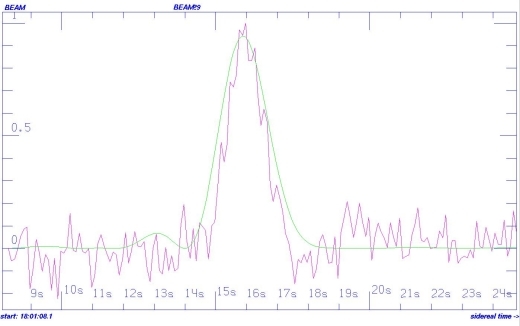Paul Gilster's Blog, page 146
August 29, 2016
At the Breakthrough Starshot Meetings
An interesting typo — I had started to write ‘On the plane back from Proxima b,’ still a bit groggy from lack of morning coffee. Let’s correct that to ‘On the plane back from San Francisco.’ I was coming back from the Breakthrough Starshot meetings, most of which took place at Moffett Field, a former naval air station that NASA owns through its adjacent Ames Research Center. Presume no NASA involvement, though — Moffett Field is used by many and includes three university branch campuses as well as the building leased by Breakthrough Starshot.
My plan had been to settle in on the plane with my notes as I worked out what to say about the trip. Instead, I succumbed to sleep for a good part of the journey. I had slept well each night, but the meetings were intense and the note-taking non-stop. I arrived two hours after the first of them began in a small boardroom, wedged myself into a chair in the corner after nodding hello to a number of familiar faces, and began taking notes by hand, since the space was too tight for my laptop. Fortunately, things sorted themselves out after the break and I could type again.
The Cast of Characters
Looking around the table, I could see Cornell’s Mason Peck, whose work on ‘sprites’ — tiny ‘spacecraft on a chip’ — has long been a topic of conversation in these pages, and one that fits tightly into the Breakthrough Starshot concept. Former Planetary Society director Lou Friedman was there, a sail pioneer who had worked with NASA’s early concept for a Halley’s Comet mission and who led the Society’s initiative into launching small sails into space. Greg Matloff (CUNY) was down the row, an interstellar researcher whose book The Starflight Handbook was the trigger for my own decision to go deeply into the topic; his wife, the artist C Bangs, was not at the meetings, but we had an enjoyable dinner conversation and museum tour.
Pete Worden is executive director of Breakthrough Starshot, a former director of NASA Ames, while Pete Klupar is the project’s director of engineering, a role he also played at Ames. Across the table I saw astrophysicist Claire Max (UC-Santa Cruz), Kelvin Long (Initiative for Interstellar Studies), software architect Kevin Parkin (Parkin Research), Roald Sagdeev (University of Maryland), the former director of the Space Research Institute in Moscow, and Princeton astrophysicist Ed Turner. I would soon meet exoplanet hunter Olivier Guyon (University of Arizona), Princeton astrophysicist Bruce Draine, Larry Krauss (Arizona State), Wes Green (Tau Technologies), and Nobel Prize winner Saul Perlmutter, who appeared at the banquet.
Martin Rees, Britain’s Astronomer Royal, was at the corner of the table, a cosmologist and astrophysicist I was delighted to meet for the first time at lunch that day. Microwave and plasma physicist Jim Benford would come in shortly after I did; his brother Greg arrived that night. Mae Jemison was there from 100 Year Starship, as was Phil Lubin, whose ideas on lasers had led to consideration of building a beamer in southern latitudes to drive Starshot’s fleet of small sails. Laser and adaptive optics specialist Bob Fugate headed up the beamer subcommittee (Jim Benford led the sail group) and Harvard’s Avi Loeb chaired the meetings.
There are too many people to simply list here — I’ll let these and others speak in the rest of my reports on Breakthrough Starshot. Suffice it to say that many people I had written about before on Centauri Dreams were involved in these meetings, some of whom I was encountering in person for the first time. There would be plenty of time to talk at the dinners each night and I’ll be reporting on some of these conversations, such as a fine evening talking to JPL’s Slava Turyshev and Olivier Guyon, and Indian food with the Benfords and UNM’s Rafael Fierro. Drinking a Sazerac with Jim Benford and UNM’s Chaouki Abdallah was a highlight.
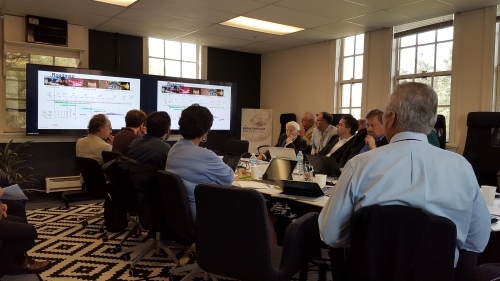
Fig02: Facing the camera at the end of the table on the left is Martin Rees. That’s Lou Friedman behind him, Slava Turychev, Kevin Parkin, Mason Peck (behind Mason is Roald Sagdeev, although hard to see). On the other side of the table, from the left with backs turned, is Larry Krauss, Claire Max, Phillip Lubin, Mae Jemison and Pete Klupar. The picture doesn’t catch many of the people sitting around the sides of the room. When we met in full committee, it was a tight but manageable squeeze. The subcommittee scenes were roomier.
The Entwined Proxima Centauri b
On the flight out, I had spent a good bit of time tweaking what I wanted to say about Proxima b. I had the discovery paper in my bag and had already written a rough draft that I would publish when the embargo lifted. As you might imagine, Proxima b was much on the minds of the Breakthrough team, all of whom were well aware of Pale Red Dot’s accomplishment in finding a provocative planet around the nearest star. The subject would dominate many conversations.
I’ve seen some reports that the discovery of Proxima’s planet has given Breakthrough Starshot its target. But I think this is a mistaken assumption. In fact, no target has yet been chosen because it’s far too early to make such a choice. What Proxima b does deliver is the first planet around another star within range of this project. We shouldn’t assume it will be the last.
Remember that we are dealing with a multi-decade project, one I’ll sketch out in more detail in tomorrow’s post. That means we have some time to work out the best choice of destinations. And right now we have not just Proxima Centauri on our doorstep, but also Centauri A and B, the former a G-class star a bit larger than the Sun, the latter a K-class dwarf of considerable interest. Either of these could have planets of their own, and within the decade or perhaps a bit beyond, we should be able to make a definitive statement about further possibilities.
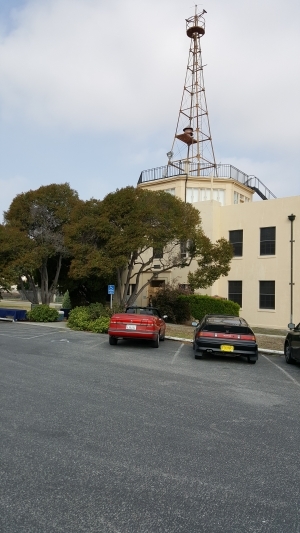
The fact that we can’t do more with Centauri A and B right now is because their angular separation in the sky is too tight. In fact, as seen from Earth, they closed to within their closest distance last spring. In coming years, as the separation again widens, we should be able to bring our radial velocity tools to bear to again delve into possible planetary systems there.
Which would you choose, if the choice were between a terrestrial-class world in the habitable zone around, say, Centauri B and a planet of similar size and interest around Proxima? My suspicion is that the Centauri B world would receive the nod, but bear in mind even as I say this that Breakthrough Starshot is envisioning not one but thousands of small sailcraft. If that scenario occurs, and given the fact that once a beamer has been built on Earth it will become a tool that can be used for many missions, we will eventually explore all three Centauri stars.
Image: Building 18 at Moffett Field. Most of the buildings in this area were built in the 1920s or so, an unusual setting for starship deliberations, but I enjoyed the irony. I also learned that Breakthrough Initiatives has purchased new facilities in downtown Palo Alto.
But I don’t think anyone at the Breakthrough Starshot meetings will forget the buzz that Proxima Centauri b caused. It is our first detected world around the closest stellar system (Centauri B’s lone planet is widely considered to have been an artifact of activity on the star itself, misread as a planetary signature), and at a dinner held at Yuri Milner’s Palo Alto estate, the scientists who spoke enjoyed referring to ‘a rumored planet’ around Proxima. It always brought a laugh because everyone knew it was the real deal, and the announcement would be the next day.
Tomorrow I’ll take a broader look at Breakthrough Starshot, its aims and possible schedule, while working in more observations from the various meetings both official and social, including more from that dinner at Yuri Milner’s estate. As we’ll see, the number of breakthroughs needed here is formidable, and my belief is that the mission outline will change substantially as the early simulations and experimental work are performed.
As occurs at any such conference, a lot of things get done at meals and in the hallways as the proximity of researchers sparks ideas. I tried to keep my head down and my ears open, so we’ll have a lot to talk about in coming days.






August 27, 2016
An Interesting SETI Candidate in Hercules
A candidate signal for SETI is a welcome sign that our efforts in that direction may one day pay off. An international team of researchers has announced the detection of “a strong signal in the direction of HD164595” in a document now being circulated through contact person Alexander Panov. The detection was made with the RATAN-600 radio telescope in Zelenchukskaya, in the Karachay–Cherkess Republic of Russia, not far from the border with Georgia in the Caucasus.
The signal was received on May 15, 2015, 18:01:15.65 (sidereal time), at a wavelength of 2.7 cm. The estimated amplitude of the signal is 750 mJy.
No one is claiming that this is the work of an extraterrestrial civilization, but it is certainly worth further study. Working out the strength of the signal, the researchers say that if it came from an isotropic beacon, it would be of a power possible only for a Kardashev Type II civilization. If it were a narrow beam signal focused on our Solar System, it would be of a power available to a Kardashev Type I civilization. The possibility of noise of one form or another cannot be ruled out, and researchers in Paris led by Jean Schneider are considering the possible microlensing of a background source by HD164595. But the signal is provocative enough that the RATAN-600 researchers are calling for permanent monitoring of this target.
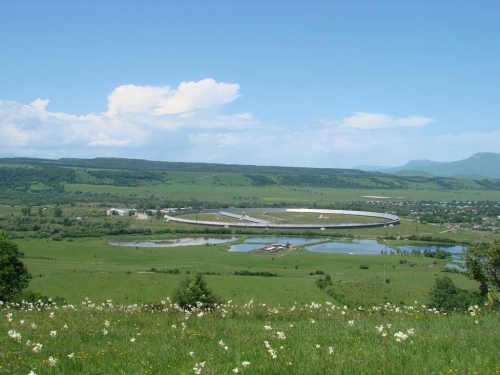
Image: The RATAN-600 radio telescope in Zelenchukskaya. Credit: Wikimedia Commons.
Here I’m drawing on a presentation forwarded to me by Claudio Maccone, from which I learn that the team behind the detection was led by N.N. Bursov and included L.N. Filippova, V.V. Filippov, L.M. Gindilis, A.D. Panov, E.S. Starikov, J. Wilson, as well as Claudio Maccone himself, the latter a familiar figure on Centauri Dreams. The work is to be discussed at a meeting of the IAA SETI Permanent Committee, to be held during the 67th International Astronautical Congress (IAC) in Guadalajara, Mexico, on Tuesday, September 27th, 2016,
What we know of HD 164595 is that it is a star of 0.99 solar masses at a distance of roughly 95 light years in the constellation Hercules, and an estimated age of 6.3 billion years. Its metallicity is almost identical to that of the Sun. A known planet in this system, HD 164595 b, is 0.05 Jupiter mass with a period of 40 days, considered to be a warm Neptune on a circular orbit. There could, of course, be other planets still undetected in this system.
Image: Strong signal from the direction of HD 164595. “Raw” record of the signal together with expected shape of the signal for point-like source in the position of HD 164595. Credit: Bursov et al.
From the presentation:
The estimated probability ~2 X 10-4 to simulate the signal from the direction of the HD164595 by signal-like noise is small, therefore HD164595 is good candidate SETI. Permanent monitoring of this target is needed.
All of which makes excellent sense. We can’t claim the detection of an extraterrestrial civilization from this observation. What we can say is that the signal is interesting and merits further scrutiny.






August 24, 2016
Proxima Centauri Planet
A planet in the habitable zone around Proxima Centauri? The prospect dazzles, but then, I’ve been thinking about just that kind of planet for most of my life. Proxima Centauri is, after all, the closest star to our own, about 15000 AU from the primary Alpha Centauri stars (though thought to be moving with that system). A dim red dwarf, Proxima wasn’t discovered until 1915, but it quickly seized the imagination of science fiction writers who pondered what might exist around such a star. Murray Leinster’s story “Proxima Centauri” (1935) is a clanking, thudding tale but it still evokes a bit of the magic of one of the earliest fictional interstellar voyages.
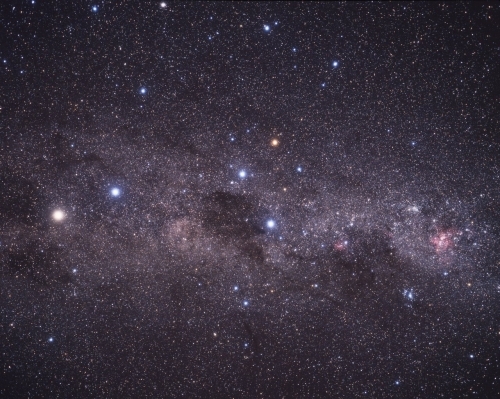
Image: This wide-field image shows the Milky Way stretching across the southern sky. The beautiful Carina Nebula (NGC 3372) is seen at the right of the image glowing in red. It is within this spiral arm of our Milky Way that the bright star cluster NGC 3603 resides. At the centre of the image is the constellation of Crux (The Southern Cross). The bright yellow/white star at the left of the image is Alpha Centauri, in fact a system of three stars, at a distance of about 4.4 light-years from Earth. The star Alpha Centauri C, Proxima Centauri, is the closest star to the Solar System. Credit: A. Fujii.
More recently, Stephen Baxter pretty much nailed Proxima Centauri b in his depiction of a just over one Earth-mass planet in the habitable zone called Per Ardua — this was in Baxter’s 2015 novel Proxima. Baxter’s planet was at 0.04 AU, and a little more massive than Earth; the real thing is 0.05 AU and 1.3 Earth masses. I would call that very nice work. Baxter has also noted, with considerable justification, that if we find a truly habitable planet in the very next system to our own, the implication is that such planets are probably quite common.
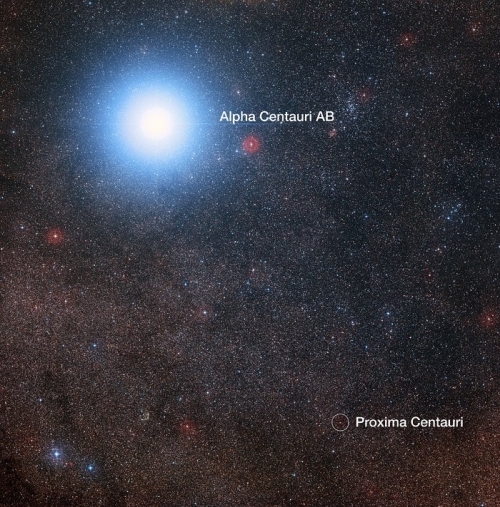
Image: This image of the sky around the bright star Alpha Centauri AB also shows the much fainter red dwarf star, Proxima Centauri, the closest star to the Solar System. The picture was created from pictures forming part of the Digitized Sky Survey 2. The blue halo around Alpha Centauri AB is an artifact of the photographic process, the star is really pale yellow in colour like the Sun. Credit: Digitized Sky Survey 2. Acknowledgement: Davide De Martin/Mahdi Zamani.
Having been at the Breakthrough Starshot meetings all this week, I’m delighted to see that we now have a potential destination; i.e. an actual rather than assumed planet around one of the stars in the system nearest to us. Finding Proxima’s planet has been a long process, drilling down to the kind of measurements that can reveal its presence. Up until now we’ve been excluding larger planets in various kinds of orbits around Proxima, but the prospect of something Earth-sized in the habitable zone remained open. I hasten to add that Breakthrough Starshot has made no decisions about its target at this point, but it’s clear that Proxima b is going to be a prime contender.

I’m going to let Guillem Anglada-Escudé, head of the Pale Red Dot project, and his collaborators describe what his team has found. Noting that uneven sampling and the longer-term variability of the star are reasons why the signal could not be confirmed from the earlier data, the researchers go on to describe these key characteristics of the planet. From the paper:
The Doppler semi-amplitude of Proxima b (∼ 1.4 ms−1) is not particularly small compared to other reported planet candidates. The uneven and sparse sampling combined with longer-term variability of the star seem to be the reasons why the signal could not be unambiguously confirmed with pre-2016 rather than the amount of data accumulated.
And here’s what we’ve been waiting to hear:
The corresponding minimum planet mass is ∼ 1.3 M⊕ . With a semi-major axis of ∼0.05 AU, it lies squarely in the center of the classical habitable zone for Proxima. As mentioned earlier, the presence of another super-Earth mass planet cannot yet be ruled out at longer orbital periods and Doppler semi-amplitudes −1 . By numerical integration of some putative orbits, we verified that the presence of such an additional planet would not compromise the orbital stability of Proxima b.
Image: Guillem Anglada-Escudé, head of the Pale Red Dot project and lead author of the paper on the discovery of Proxima Centauri b.
And there we are, our first assessment of a planetary system around Proxima Centauri. The team’s analysis taps into previous Doppler measurements of Proxima Centauri coupled with the follow-up Pale Red Dot campaign of 2016. The Doppler data draws on the HARPS (High Accuracy Radial velocity Planet Searcher) spectrometer and UVES (the Ultraviolet and Visual Echelle Spectrograph). The search methods and signal assessment are thoroughly discussed in the paper (citation below). Key to the effort was what Anglada-Escudé and team call “[a] well isolated peak at ∼11.2 days” that appeared in the pre-2016 Doppler data. The HARPS Pale Red Dot campaign was created to confirm or refute this 11.2-day signal. And confirm it they did.
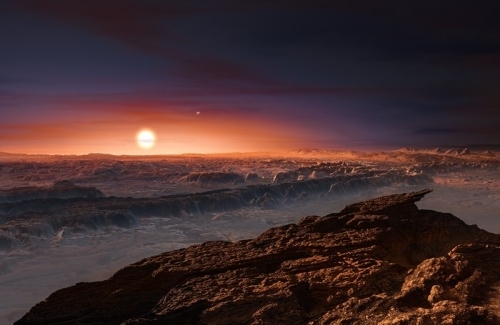
Image: This artist’s impression shows a view of the surface of the planet Proxima b orbiting the red dwarf star Proxima Centauri, the closest star to the Solar System. The double star Alpha Centauri AB also appears in the image to the upper-right of Proxima itself. Proxima b is a little more massive than the Earth and orbits in the habitable zone around Proxima Centauri, where the temperature is suitable for liquid water to exist on its surface. Credit: ESO/M. Kornmesser.
We have a long way to go before knowing whether a planet around a red dwarf like this can truly be habitable. Tidal locking is always an issue because a planet this close to its host (Proxima Centauri b is on an 11.2-day orbit) is probably going to have one side fixed facing the star, the other in permanent night. There are papers arguing, however, that tidal lock does not prevent a stable atmosphere with global circulation and heat distribution from occurring.
And what about Proxima’s magnetic field? The average global magnetic flux is high compared to the Sun’s (600±150 Gauss vs. the Sun’s 1 G). Couple this with flare activity and there are scenarios where a planet gradually has its atmosphere stripped away. A strong planetary magnetic field could, however, prevent this erosion. Nor would X-rays (400 times the flux the Earth receives) necessarily destroy the planet’s ability to keep an atmosphere.
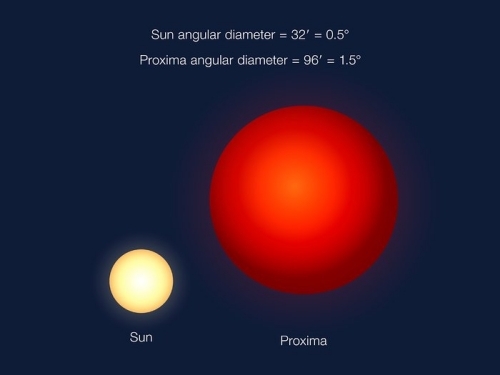
Image: An angular size comparison of how Proxima will appear in the sky seen from Proxima b, compared to how the Sun appears in our sky on Earth. Proxima is much smaller than the Sun, but Proxima b lies very close to its star. Credit: ESO/G. Coleman.
And then there’s the matter of the planet’s origins, and how that could affect what is found there. From the paper:
…forming Proxima b from in-situ disk material is implausible because disk models for small stars would contain less than 1 M Earth of solids within the central AU. Instead, either 1) the planet migrated in via type I migration, 2) planetary embryos migrated in and coalesced at the current planet’s orbit, or 3) pebbles/small planetesimals migrated via aerodynamic drag and later coagulated into a larger body. While migrated planets and embryos originating beyond the ice-line would be volatile rich, pebble migration would produce much drier worlds.
We can now hope for further data on Proxima Centauri b through transit searches, direct imaging and further spectroscopy. Ultimately, of course, we can think about the prospects of robotic exploration, the sort of thing we’ve been discussing here on Centauri Dreams for the last twelve years. No star is closer, and few will reward follow-up study more than this one. I need to get into a meeting and will have to let that wrap this up, but you can be sure there will be a lot more to say about Proxima and the entire Alpha Centauri system as the analysis continues.
The paper is Anglada-Escudé et al., “A terrestrial planet candidate in a temperate orbit around Proxima Centauri,” Nature 536 (25 August 2016), 437-440 (abstract).
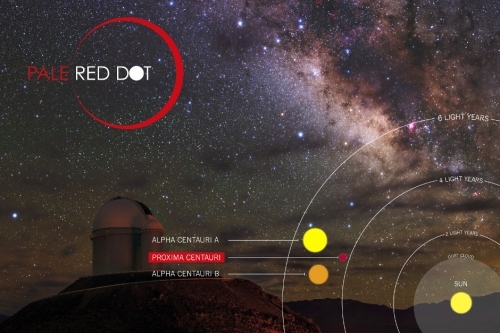






August 23, 2016
Breakthrough Starshot Meetings
I’m at the Breakthrough Starshot meetings in San Francisco, with a full schedule indeed. As I did last time in Palo Alto, I won’t try to post daily because there just won’t be time, and in any case, I will need to go over my notes and consolidate my impressions. Even so, I plan to slip something interesting in here in the near future (keep an eye on Wednesday afternoon EDT), and will try to keep comment moderation active, though probably on a more infrequent basis than usual. Next week I’ll report in on what happened at the committee level at Breakthrough Starshot.






August 18, 2016
Getting Ready for OSIRIS-REx
Back in the 1930s, the German astronomer Karl Reinmuth discovered a near-Earth asteroid now called 1862 Apollo, which gave its name to the Apollo asteroids, all of them Earth-crossing and of high interest to those looking to plan asteroid missions. The number of known Apollo asteroids totals close to 7000. The one that gains our attention today is 101955 Bennu, for this is the target of the upcoming OSIRIS-REx mission, scheduled for launch on September 8.
Standing for Origins, Spectral Interpretation, Resource Identification, Security-Regolith Explorer, OSIRIS-REx is a sample return mission that will, if all goes well, reach Bennu in 2018, surveying the asteroid from nearby space for 505 days in search of optimum sampling sites. The plan is for no actual landing but a very close approach in which the spacecraft’s extended robotic arm will attempt to gather the sample. The robotic arm (known as TAGSAM, for Touch-And-Go Sample Acquisition Mechanism) will collect between 60 and 2,000 grams of surface material.
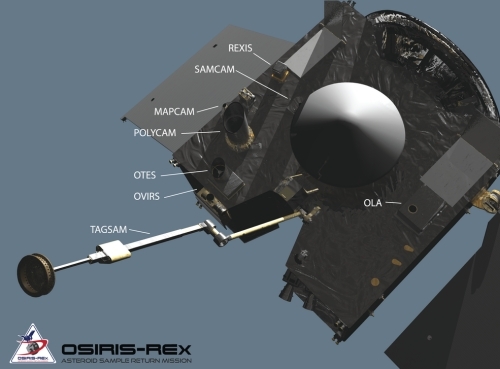
Image: The Origins, Spectral Interpretation, Resource Identification, Security-Regolith Explorer (OSIRIS-REx) spacecraft will travel to a near-Earth asteroid, called Bennu (formerly 1999 RQ36), and bring at least a 60-gram sample back to Earth for study. The mission will help scientists investigate how planets formed and how life began, as well as improve our understanding of asteroids that could impact Earth. Credit: NASA/University of Arizona.
Like 2001 CQ36, which we talked about yesterday in relation to Deep Space Industries’ Prospector-1 mission, Bennu is a potential Earth impactor and thus offers dual service in terms of pure science and planetary defense. The asteroid has a diameter of approximately 500 meters and, as you can see from the images below, has been surveyed by the planetary radar facilities at both Arecibo and Goldstone. The low delta-v required to reach it from Earth orbit makes it a prime candidate for close study, and we should have samples by 2023.
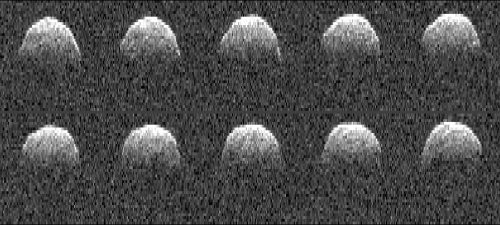
Image: These radar images of Bennu were obtained by NASA’s Deep Space Network antenna in Goldstone, Calif. on Sept 23, 1999. NASA detects, tracks and characterizes asteroids and comets passing close to Earth using both ground- and space-based telescopes. The Near-Earth Object Observations Program at NASA’s Jet Propulsion Laboratory in Pasadena, Calif., commonly called “Spaceguard,” discovers these objects, characterizes some of them, and plots their orbits to determine if any could be potentially hazardous to our planet. Credit: NASA/JPL-Caltech.
One reason images like these are important is that the precise measurement of an asteroid’s trajectory depends upon the Yarkovsky effect, which depicts the forces upon a rotating object as it heats. The effect can be subtle but over time can make for serious changes in an asteroid’s orbit. The asteroid 6489 Golevka, as measured between 1991 and 2003, drifted 15 kilometers from its predicted position. When we’re dealing with nearby asteroids and trying to make sure they don’t present a hazard to Earth, small changes like this can obviously be critical.
Learning the exact shape of an asteroid, along with its orientation and albedo, helps us produce more accurate predictions. That makes the Yarkovsky effect anything but theoretical, and in fact there are proposed asteroid deflection schemes based on it, some focusing sunlight on the object, some changing a small asteroid’s albedo by painting the surface with reflective coatings. OSIRIS-REx, as part of its numerous studies at Bennu, will be measuring the Yarkovsky effect.
The scientific payoff should be impressive as we look to learn more about the formation and evolution of the Solar System. Asteroids are leftovers from the system’s earliest days, and as we’ve seen from the Deep Space Industries plans, they’re also packed with natural resources like water, organics and metals. A carbon-rich sample from Bennu will help us probe the regolith layer at the sample site and understand the chemistry and mineralogy of such objects.
OSIRIS-REx is scheduled to launch on Sept. 8, 2016, at 1905 EDT (2305 UTC).






August 17, 2016
A Near-Term Commercial Asteroid Mining Mission
Most readers will recall the Spacecoach, developed by Brian McConnell and Alex Tolley and widely discussed in these pages. A workhorse spacecraft designed to shuttle crew and cargo between Earth and nearby planets, the Spacecoach was presented as a way to open up regular commercial use of the Solar System, on the pattern of the stagecoaches that connected towns in the American Old West. One of the many beauties of the Spacecoach was the idea of using reclaimed water and waste gases as a propellant in its electric engines.
With water as a propellant, the mass of the system can be sharply reduced, with an associated reduction in mission costs. Benefits like that don’t stay hidden for long, and I see that Deep Space Industries is likewise attracted to water in the design of its new engine. The Prospector-1 spacecraft, slated for launch by the end of the decade, uses a system DSI calls ‘Comet.’ It expels superheated water to create thrust, a useful idea given the company’s intentions.
“During the next decade, we will begin the harvest of space resources from asteroids,” said Daniel Faber, CEO at Deep Space Industries. “We are changing the paradigm of business operations in space, from one where our customers carry everything with them, to one in which the supplies they need are waiting for them when they get there.”
And as Faber’s news release is quick to point out, water will be early on the list of asteroid mining products, meaning that the company realizes the importance of refueling in space. Prospector-1 is being developed as the world’s first commercial interplanetary mining mission, designed to rendezvous with a near-Earth asteroid and evaluate its potential for mining operations. The plan is to key off the earlier Prospector-X mission, which will test DSI technologies in low-Earth orbit as a precursor to the more ambitious Prospector-1.
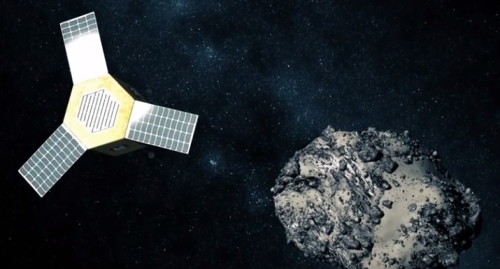
Image: Artist’s conception of Prospector-1, Deep Space Industries’ planned commercial mining mission, approaching a near-Earth asteroid. Credit: DSI.
We’ve had good views of asteroids from a number of missions now, including Galileo, Hayabusa, which landed on the asteroid Itokawa and returned samples to Earth, NEAR-Shoemaker, Deep Space 1 and, of course, Dawn, which continues to provide us with high quality data from Ceres after its long period of operations at Vesta. The list could be extended, for as you can see above, many missions, like Galileo and Cassini, imaged asteroids on their way to their final destinations. It was Jupiter-bound Galileo that discovered that the asteroid Ida had a small satellite (Dactyl). Galileo also imaged the asteroid Gaspra.
Prospector-1’s asteroid is to be chosen from the host of near-Earth asteroids, with mapping operations of its surface and subsurface, visual and infrared imaging and analysis of water content down to a depth of one meter. After the initial science campaign, Prospector-1 will use its water thrusters to make a touchdown on the asteroid for further analysis. “The ability to locate, travel to, and analyze potentially rich supplies of space resources is critical to our plans,” continued Faber. “This means not just looking at the target, but actually making contact.”
In Living Off the Land in Space (Copernicus, 2007), Gregory Matloff, Les Johnson and C Bangs looked at asteroid mining as one possibility in a program of long-term human migration off our planet. The authors drew particular attention to the asteroid 2001 CQ36, a near-Earth object with a diameter estimated to be between 90 and 300 meters. 2001 CQ36 might be an excellent asteroid for an early look by a space mining company, given not only its resource potential but the fact that it is on an orbit that could potentially cause problems.
The asteroid approaches the Earth in 2021, 2022, 2031 and 2033, with the 2031 pass closing to 0.02 AU. Assuming a diameter of 150 meters, Matloff, Johnson and Bangs work out an estimated mass of 3 billion kilograms (this also assumes a spherical shape and a specific gravity intermediate between water and rock). 2001 CQ36 is not the sort of thing we want to see impact the Earth, which makes close study of its composition a long-term insurance policy, just in case we ever have to consider nudging an asteroid like this onto a new trajectory.
From the mining perspective, get just a third of the resources available at 2001 CQ36 and you’ve got a billion kilograms of material for space manufacturing. So doubling up on our objectives would seem to make sense when we have objects that can be studied and exploited from both perspectives. Prospector-1 is small (50 kg when fueled) and low cost, intended as a platform for early asteroid mining studies and other forms of inner system exploration. We’ll track its fortunes closely.






August 16, 2016
Brown Dwarf Analysis Offers Exoplanet Implications
Brown dwarfs offer exciting prospects for exoplanet work. Not only are we learning that they can have planets of their own, but brown dwarfs themselves are a useful bridge between planets and stars. We also know that there are a lot of them out there. According to data from the WISE (Wide-field Infrared Survey Explorer) mission, there is about one brown dwarf for every six main sequence stars. That’s plenty of brown dwarfs, but it actually represents a reduction in estimates, which once went as high as a brown dwarf for every star.
Moreover, WISE could identify about 200 brown dwarfs relatively near the Sun, with 33 within 26 light years. 211 stars are found in that same volume, incidentally. If we extrapolate this out to the galaxy at large, we should have about 33 billion brown dwarfs, assuming a galactic total of 200 billion stars. These numbers have a certain flexibility in them, especially given how hard it can be to track the coolest Y-dwarfs. Added to this is the fact that brown dwarfs fade with time.
Once we get below about 75 Jupiter masses, an object cannot ignite hydrogen fusion. That has broad implications for how brown dwarfs evolve. After formation, they continually cool and contract with time, with a concomitant increase in surface gravity. Thus across the age range we find brown dwarfs in heat regimes not that dissimilar from a small star, while others are as cool as a planet. Brown dwarf contraction in this mass range is opposed by electron degeneracy, so despite gradual constriction, the object never reaches the temperature for nuclear fusion.

Image: Brown dwarfs in relation to more familiar celestial objects. Credit: Gemini Observatory/Jon Lomberg.
Brown Dwarfs as Bridge
What we do get is a significant bridge between stars and planets. In a new paper, Jacqueline Faherty (Carnegie Institution for Science) and colleagues analyze the properties of 152 suspected young brown dwarfs, objects that show tremendous diversity in mass, age and chemical composition. Finding where many of the brown dwarfs formed allowed the team to eliminate age and chemical composition as the primary cause of their differences.
Faherty’s kinematic study adds new radial velocities, proper motions and parallaxes for a number of these objects, finding 39 brown dwarfs that appear to be members of nearby moving groups, indicating similar age. Another 92 objects are considered ‘ambiguous members,’ while 21 belong to no moving group. Using the moving group membership as an age calibration, the paper looks at the wide range of color and spectral features, making the case that atmospheric conditions are responsible for many of the observed differences between brown dwarfs.
Objects with masses Jup cool through their lives with spectral energy distributions evolving as their atmospheric chemistry changes with decreasing temperatures…At the warmest temperatures, the atmosphere is too hot for the condensation of solids…But as the Teff [effective temperature] falls below 2500 K, both liquid (e.g. Fe) and solid (e.g. CaTiO3, VO) mineral and metal condensates settle into discrete cloud layers…
It’s a process that will continue to affect our observations:
As temperatures cool further, cloud layers form at such deep levels in the photosphere that they have little or no impact on the emergent spectrum. This transition between “cloudy” to “cloudless” objects occurs rapidly over a narrow temperature range (1200-1400 K, corresponding to the transition between L-type and T-type spectra) and drives extreme photometric, spectroscopic, and luminosity changes.
Faherty considers young brown dwarfs like these to be siblings of the giant exoplanets we have seen through direct imaging, which means that quantifying their observable properties should help us better understand how young gas giant planets evolve. In many ways we can consider them exoplanet analogs, but exoplanets without the distracting light of their host star. We can study young, warm exoplanets for evidence of the same kind of atmosphere-related changes.
The overlap between brown dwarfs and planets is striking, offering fertile ground for further work:
In general, M, L, T, and Y classifications identify brown dwarfs. If the source is older (> 2 – 3 Gyr), late-type M and early L dwarfs are stars. But if the source is young (< 1 Gyr), even those warmer classifications will describe an object that is < 75 MJup. To date, all directly imaged giant exoplanets have observable properties which lead to their classification squarely in this well-studied regime. Planetary mass companions such as 2M1207 b, 51 Eri b, β Pictoris b, ROXs 42B b, and the giant planets orbiting HR8799, have observables that are similar to L or T brown dwarfs…Furthermore, there exists a population of “classical” brown dwarfs that overlap in effective temperature, age – many in the same moving group – and mass with directly observed planetary mass companions (e.g. PSO 318, SDSS1110, 0047+6803…
These early cuts at deep classification of brown dwarfs are obviously going to get even deeper as we accumulate more data, but the analysis by moving groups offers us a useful way to frame the issue. Pondering Faherty’s work on my morning walk (in an already sweltering 90° F), I found myself recalling an interesting analysis of brown dwarf atmospheres from a few years back. A bit of poking around on the Net later confirmed that this was a study of the brown dwarf ULAS J222711-004547. The work, by Frederico Marocco (University of Hertfordshire) and team, analyzed clouds of mineral dust, all floating in an atmosphere of water vapor, methane and (possibly) ammonia.
ULAS J222711-004547 turns out to be one of the reddest brown dwarfs we’ve ever found. Marocco’s paper refers to it as ‘a peculiar L dwarf,’ and identifies nine other objects in the same category. The researchers consider these unusually red L-dwarfs to be a bridge between brown dwarfs and giant planets atmospheres, thus a useful test bed for the atmospheric models that Faherty so painstakingly analyzes in her later work. In such ways does the analysis of dust clouds in brown dwarfs add insight into our models of young exoplanet atmospheres.
The paper is Faherty et al., “Population Properties of Brown Dwarf Analogs to Exoplanets,” accepted for publication in the Astrophysical Journal Supplement Series (preprint). The Marocco paper is “The extremely red L dwarf ULAS J222711−004547 – dominated by dust,” Monthly Notices of the Royal Astronomical Society, published online February 5, 2014 (full text). I wrote about this one back in 2014 in Unusually Red Brown Dwarfs (and What They Tell Us).






August 15, 2016
Niku: A ‘Rebellious’ Trans-Neptunian Object
We’ve all come to terms with the fact that beyond the orbit of Neptune there exists a large number of objects. These trans-Neptunian objects (TNOs) substantially altered the almost sedate view of the Solar System that prevailed in the first half of the 20th Century, showing us that far from being a tame and orderly place of planets, asteroids and comets, we were in a system filled with material left over the the system’s formation. Tame and orderly became ragged and unkempt, and it was clear that the outer system was a place ripe for discovery.
Pluto was the first TNO to be discovered, all the way back in 1930, but the modern era of trans-Neptunian objects began in 1992 with the discovery of (15760) 1992 QB, and we can now count over 1750 TNOs, as listed by the Minor Planet Center. Bear in mind that we can divide the entire space occupied by TNOs into several prominent divisions: the Kuiper Belt, the Oort Cloud, and the scattered disk, with a few outliers like Sedna causing continuing controversy.

Image: Artist’s impression of a trans-Neptunian object. Credit: © NASA, ESA, and G. Bacon (STScI).
Which gets us to another controversial object, an unusual world its discoverers have named Niku. Probably less than 200 kilometers in diameter, Niku’s outstanding characteristic is that its orbital plane is tilted 110 degrees to the plane of the Solar System. The object is in a retrograde orbit, moving around the Sun in a direction opposite to the rest of the planets. We have one other TNO that fits the retrograde classification: 2008 KV42.
The paper on Niku, produced by Ying-Tung Chen (Academia Sinica, Taipei) and colleagues points out that 2008 KV42 has previously been the subject of dynamical simulations that show its orbit has a lifetime stable for billions of years. The researchers believe the Kuiper Belt is an unlikely origin for such a retrograde object, which may implicate the Oort Cloud, but the orbital dynamics of this population of objects await a good deal of further work.
Discovered as part of the Panoramic Survey Telescope and Rapid Response System 1 Survey (Pan-STARRS 1) in Hawaii, Niku is another indication that something is preserving the orbits of these objects. The team’s simulations — using 1000 clones and moving them forward for a period of one billion years — show stable orbits matching the location of Niku and 2008 KV42, hence indicating the possibility of a large population with similar origins.
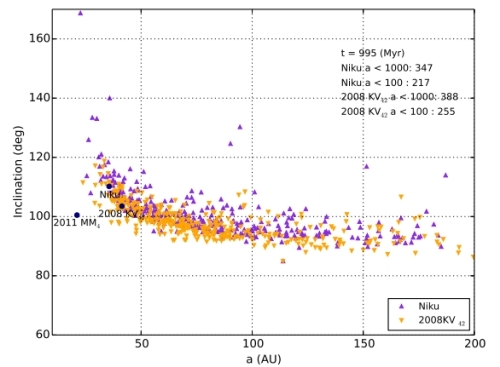
Image: The orbital distribution of survivors from 1000 initial clones of Niku (purple) and 2008 KV42 (orange) after 1 Gyr approximately. The overall clones decay far more slowly than normal Centaurs, with > 30% of the test particles remaining dynamical stability at the end of a 1 Gyr integration. Note that the orbits of Niku and 2008 KV42 are located at the highest density position in this plot. Credit: Chen et al.
What would cause clustering in the orbits of known objects with highly inclined orbits? To make sense of it, the team turned to known high-inclination objects from the Minor Planet Center catalog, selecting them according to criteria drawn loosely from their simulations. We have a small number of samples — the team was working with only six objects. Even so, the probability of getting six objects into a common plane is low enough to argue against coincidence. And because orbital precession should prevent long-term clustering, the authors assume that another mechanism has to explain it. Planet Nine immediately comes to mind, the hypothesized world that may lurk in the Solar System’s outer reaches. Evidence for Planet Nine, after all, comes from a similar group of objects in highly inclined orbits.
But a hypothetical Planet Nine, an undiscovered dwarf planet in the scattered disk, and a distant solar companion all fail when subjected to the team’s analysis. To explain the observed clustering requires some kind of mechanism that remains undiscovered. In the quotation from the paper below, Ω refers to the longitude of the ascending node, one of the orbital elements used to specify key orbital parameters. It is here that the clustering is observed:
…we established through numerical integrations that the putative Planet Nine was unable to explain the orbital confinement. In addition, we also attempted more extreme alternative scenarios, consisting of integrations that include a synthetic high-inclination dwarf planet of a few Earth masses whose orbit crosses the giant planet region. None of these attempts succeeded in anchoring the Ω of the test particles. Moreover, adding a planet into planet-crossing region has a very high chance of disrupting the orbital structure of the Kuiper Belt and remaining outer Solar System.
Niku’s orbit is a mystery — no wonder its name means ‘rebellious’ in Chinese. We could use a lot more data on objects like Niku to help us understand their apparently long-lived orbital plane and the factors that keep it stable. The authors point to projects like the upcoming Large Synoptic Survey Telescope (LSST) survey that will perform a ten-year scan producing a 200 petabyte set of images beginning in 2022. We can hope the LSST survey will uncover whatever object or objects are responsible for sculpting the orbits of these high-inclination TNOs.
The paper is Ying-Tung Chen et al., “Discovery of A New Retrograde Trans-Neptunian Object: Hint of A Common Orbital Plane for Low Semi-Major Axis, High Inclination TNOs and Centaurs,” accepted at Astrophysical Journal Letters (preprint).






August 12, 2016
Evening Landscape with Exomoons
I often work out my thoughts on the topics we discuss here while taking long walks. I try to get in five miles a day but more often it’s about three. In any case, these long, reflective walks identify me as the neighborhood eccentric, an identity that is confirmed by the things I write about. What’s interesting about that is that so many people have a genuine interest in the stars and how we might get there. Some of the best questions I’ve ever had have been from people whose interest is casual but persistent, and one good question usually leads to another.
Hence I wasn’t surprised on yesterday’s walk to find myself talking with a neighbor about exomoons and why we study them. After all, we have a Solar System in which moons are commonplace. Isn’t it perfectly obvious that different solar systems would have planets with moons?
The answer is yes, but it also follows that things that seem perfectly obvious still have to be confirmed. But let’s unpack it a bit more than that. We’re familiar with our own system’s configuration, in which moons of astrobiological interest are orbiting gas giants a long way from the inner system. But we know from our exoplanet work that large planets like these can exist in warmer places. Thus the notion of habitable moons around gas giants, or perhaps double planets in the habitable zone, something like a larger version of Pluto and Charon in a comfortable orbit.
Popular films like Avatar keep the exomoon theme in front of the public, whose interest is understandable. After all, could anything be more exotic than a warm gas giant orbited by something a bit like the Earth? From an astrobiological perspective, the thought of Europa or Titan analogs in warm orbits is thrilling, a reminder that life may have gained many footholds in the galaxy. The Hunt for Exomoons with Kepler project is all about figuring out the occurrence rate of large moons so we can learn whether such moons are common.
The other aspect of exomoon detection has to do with increasing our expertise. It wasn’t so long ago that we had yet to detect our first exoplanet. Now we’re delving into planetary atmospheres and working out the orbital dynamics of multi-planet systems. An exomoon detection would be a major proof of concept, demonstrating the growth of our skills. It would also begin to build an exomoon catalog that will help us understand how important exomoons may be to planetary habitability. How big a role does our own moon play in keeping our planet habitable?
There’s also plenty to learn about how planetary systems form in the first place. We now think our Moon formed in a massive collision (the Big Whack) with a Mars-sized object in the early days of our planet’s history. How likely an event is this, and how often does it happen in other Solar Systems? We still have a lot to learn about how the satellite systems around various planets emerge, especially when we consider the wild variety of moons we see in our Solar System. Building the exomoon catalog will help answer these questions.
The Joys of Beta Pictoris b
I hadn’t planned to get into exomoons today, but serendipity struck. After yesterday’s conversation I ran across Phil Plait’s latest essay for Slate. The popular astronomer and science popularizer (author of Death from the Skies! and, of course, Bad Astronomy), now explains that because of an unusual alignment beginning in 2017, we may be able to detect an exomoon, if there is one, around the planet Beta Pictoris b.
We’re dealing with a system far different from our own. Some 60 light years away, the star Beta Pictoris is more massive than the Sun and a mere infant, at 25 million years old, compared to our own star (around 4.5 billion years). This is a solar system in formation. Moreover, it has been under intensive study since scientists realized it was surrounded by a large circumstellar disk. The planet Beta Pictoris b was first imaged in 2003, a world more massive than Jupiter that orbits its host every 20 years. You can see its movement in the time-spaced images below.
Image: Infrared images of the planet β Pictoris b obtained in 2003 (a), 2009 (b) and 2010 (c), showing the planet’s movement in an orbital plane that is nearly edge-on as seen from Earth. The host star is in the central part, but its light has been suppressed to show the fainter planet. The white dots in b and c denote previous positions of the planet. Faint blobs are optical effects. It is not possible to tell from these images whether the planet is orbiting towards or away from us, but {Ignas] Snellen and colleagues’ spectroscopic observations clearly indicate that the planet is currently in a part of its orbit where it is moving towards us. Credit: ESO.
Note in the description above that the planet’s orbital plane is close to edge-on from our perspective. It’s not close enough to make a transit possible, but what Plait talks about is
the next best thing. Drawing on a paper by Jason Wang (UC-Berkeley) and colleagues, Plait explains that the region around the planet called its Hill Sphere will pass in front of the star from our perspective. The Hill Sphere is the area around an astronomical body in which its gravity dominates. In other words, within the Hill Sphere, a moon could be retained by the planet.
Nobody explains such concepts as well as Phil Plait, so I’ll give him the floor here, drawing directly from his essay:
The size of the sphere depends on the mass of the planet, the mass of the star, and the distance between them. For example, the Earth’s Hill sphere reaches out to about 1.5 million kilometers. The Moon, orbiting 380,000 km away, is well inside that, so its motion is mostly influenced by the Earth (some people like to say the Moon orbits the Sun more than it does the Earth, but those people are wrong). Weirdly, Pluto’s Hill sphere is much larger than Earth’s, but that’s because it’s so far from the Sun that an object can orbit Pluto from farther away and still be heavily influenced by it.
What emerges with regard to Beta Pictoris b is that its Hill Sphere is 160 million kilometers in radius. We get no transit of the star by the planet itself, but by August of 2017, the planet will be at its closest approach to the star and the Hill Sphere region will transit. We’ll be able to look for debris or exomoons. A large moon passing in front of the star would be the first entry in the exomoon catalog.
But even if we get no exomoon detection, bear in mind that we may make other interesting observations. This young planet is still being born, and it may well contain a circumplanetary disk of its own, or even a ring system that is the residue of planet formation. “The transit of β Pic b’s Hill sphere,” Wang et al. write, “should be our best chance in the near future to investigate young circumplanetary material.” We’ll also learn a lot more about how Beta Pictoris b perturbs the circumstellar disk, a window into early solar system formation.
All this is good material for my next walk and the conversations sure to follow. The paper is Wang et al., “The Orbit and Transit Prospects for β Pictoris b constrained with One Milliarcsecond Astrometry,” accepted at the Astrophysical Journal (preprint).






August 11, 2016
Liquid Methane in Titan’s Canyons
It was in 2012 that Cassini data showed us the presence of the river system now called Vid Flumina, which empties into Titan’s Ligeia Mare after a journey of more than 400 kilometers. Given surface temperatures on this largest of Saturn’s moons, researchers assumed liquid methane would be the key player here. The question was whether the river — and the eight canyons that branched off from it along its course — were still filled with liquid or long dry.

Now we have the answer, thanks to new work from Valerio Poggiali (La Sapienza University, Rome) and colleagues. Using radar signals bounced off Titan’s surface in May of 2013, the researchers probed the deep gorges near Titan’s north pole and were able to distinguish rocky material from smooth liquid. We’re clearly looking at a surface that is actively eroding, one with striking comparisons to the landscapes of Utah and Arizona as well as the Nile River gorge.
Key to the work here is the use of Cassini’s radar as an altimeter, measuring the height of features on the surface. Poggiali and team were able to use the altimetry data in combination with previous radar imagery of the area to analyze the Vid Flamina channels. Radar returns from the channels are highly reflective, producing a telltale glint, and the radar backscatter in relation to nearby terrain implicates smooth surfaces. From the paper:
…we interpret these smoothness constraints as requiring liquid surfaces. This represents the first direct detection of liquid-filled channels on Titan. Furthermore, channels exhibit canyon-like morphology, with the liquid surface elevations of the higher-order tributaries of the Vid Flumina network…occurring at the same elevation as Ligeia Mare. We also find lower order tributaries with liquid surface elevations above the level of Ligeia Mare, consistent with elevated tributary networks feeding into the main channel system.
The canyons branching off from Vid Flumina are less than a kilometer wide, with walls as high as 570 meters. They were likely carved by the liquid methane as it drained into Vid Flumina, a process we see on Earth in the shaping of river gorges. These are steep walls, rising as sharply as 40 degrees. What remains unknown is the age of the processes at work here, and the depth of the liquid methane. What we can assume is that the presence of liquid in these canyons reflects a process of canyon formation that is ongoing on this active geological surface.
Image: Liquid methane and ethane flowing through Vid Flumina, a 400-kilometer long river often compared to Earth’s Nile River, is fed by canyon channels running hundreds of meters deep. Credit: NASA, JPL-Caltech, Agenzia Spaziale Italiana.
Such steep clefts in Titan’s landscape could be the result of several processes including terrain uplift and changes in sea level. This JPL news release draws comparisons with the Grand Canyon, where rising terrain caused the Colorado River to cut deeply into the landscape below over a timespan of several million years. But canyons formed from changes in water level are also found on Earth, as is evident at Lake Powell, a reservoir that straddles the border between Arizona and Utah. Here, the Colorado’s rate of erosion increases when the water level in the reservoir drops. On Titan, both process may be in play.
“It’s likely that a combination of these forces contributed to the formation of the deep canyons,” says Poggiali, “but at present it’s not clear to what degree each was involved. What is clear is that any description of Titan’s geological evolution needs to be able to explain how the canyons got there.”
[image error]
Image: NASA’s Cassini spacecraft pinged the surface of Titan with microwaves, finding that some channels are deep, steep-sided canyons filled with liquid hydrocarbons. One such feature is Vid Flumina, the branching network of narrow lines in the upper-left quadrant of the image. Credit: NASA/JPL-Caltech/ASI.
We have other channels to study on Titan, and many may be hidden below the resolution of the Cassini instruments. But bear in mind as well that when the Cassini mission ends on September 15 of next year, we will have used its radar in imaging mode to cover a total area of 67 percent of the surface. That’s a triumph for the mission, but also a reminder of how much we leave unseen. No matter how successful the mission, it always points to what needs study next.
The paper is Poggiali et al., “Liquid-filled canyons on Titan,” published online by Geophysical Research Letters 9 August 2016 (abstract).






Paul Gilster's Blog
- Paul Gilster's profile
- 7 followers


